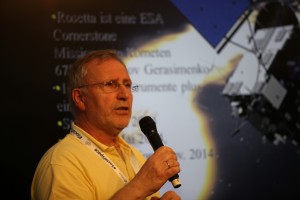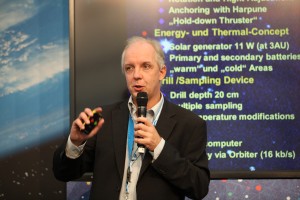It’s been a long wait for a mission first thought of almost thirty years ago. Launched in 2004, ESA Rosetta will wake up from its hibernation in January 2014, and have the year of its life as it prepares to encounter comet 67P/Churyumov–Gerasimenko and deploy the lander, Philae.

Former ESA Project Manager for Rosetta, Gerhard Schwehm, explains the beginnings of the mission and its objectives Credit: DLR/ESA/A. Morellon (CC-BY 3.0)
Former ESA Project Manager for Rosetta, Gerhard Schwehm, filled in SocialSpace on the story so far.
“I was a study scientist for Rosetta right from the beginning. We wanted to take a sample from a comet back to Earth to study with our most sophisticated instruments. Because of changes in the mission, we figured out that instead of bringing the sample back, we needed to bring a laboratory to a comet.”
The audacious mission plan developed for Rosetta includes a first attempt to spend time in orbit with a comet, rather than flying by. It should give a much more complete picture of the comet and its genesis.
“If you collect something on the fly you don’t know the context of the bits you have collected,” says Schwehm, “To go there and stay we can put things in context.”
Carrying primitive material from the early Solar System, the comet should tell us more about the environment when Earth was forming.
“We won’t find life in comets,” Schwehm says, “But we need the next pieces in the puzzle of how the planets were formed, how Earth formed and how life on Earth began to evolve.”

Stephan Ulamec of DLR explains the challenges and opportunities for the Philae lander Credit: DLR/ESA/A. Morellon (CC-BY 3.0)
DLR’s Stephan Ulamec, Head for the Rosetta Lander, detailed the instruments on board Philae, Rosetta’s lander. The 100kg lander carries a range of the instruments to investigate the comet, and uses expertise from many different groups internationally. A full description of the instruments is available here.
Nobody has attempted a soft landing on a comet before. Ulamec explained that it’s impossible to know what kind of surface Philae will encounter: “It could be soft like fresh snow, or hard like packed ice. We just don’t know.”
The nucleus of a small comet like 67P is too small to be resolved from Earth – so there is very limited information available to the team. The big reveal will come in 2014.
“We’ve already had some highlights with flybys of Mars and two asteroids. But next year will be the crucial time.”

Discussion: one comment
Visiting the Philae control room and talking to its people for almost an hour was *the* highlight of TdLR13 for me – here is a report on what I saw & learned: https://skyweek.wordpress.com/2013/09/22/viele-unwagbarkeiten-vor-1-kometenlandung